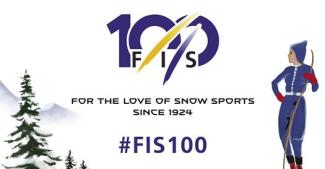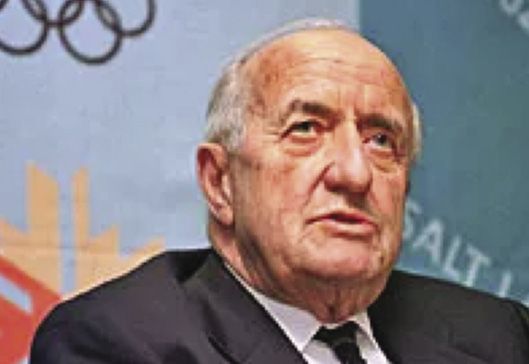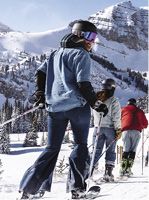FIS at 100 Looks to the Future

But no plans yet for a birthday party
The Fédération Internationale de Ski, or FIS, was formally founded on February 2, 1924, during the first Winter Olympics at Chamonix, by 14 national ski associations (see “1924: The First Winter Games” in the January-February 2024 issue). They wanted a stronger governing body for skiing to succeed the 10-nation International Skiing Commission, established in 1910 in Oslo. FIS now controls more than half of Winter Olympic competitions with its dozen different disciplines in skiing and snowboarding.

The original organization was meant to regulate competitions in the traditional Nordic disciplines (jumping, cross-country and Nordic combined) in an era when only Scandinavian populations conducted major events such as the Nordic Games (Stockholm, as of 1901), the Holmenkollen Ski Festival (Oslo, from 1892) and numerous annual—and popular—jumping meets in North America (beginning around 1887).
International competition required coordination of national ski associations (NSAs). The first of these, the
Bohemian Ski Association and Ski Club of Great Britain, were founded in 1903, followed by clubs in Switzerland (1904); Austria, Germany and the United States (1905); and the Scandinavian countries (1908).
The sport was expanding beyond Nordic into what would become the Alpine disciplines. In January 1905, Matthias Zdarsky invented the Torlauf, or “gate run,” an untimed descent around obstacles that is now regarded as a precedent for the timed slalom, which was created in 1922 by Arnold Lunn. According to the local newspaper Kitzbüheler Bote, the first real Alpine competition took place at Kitzbühel, where a series of open-field downhill competitions was held in January and April of 1906.
The winner of the main event on April 8, Sebastian Monitzer, needed more than eight minutes to descend 2,050 feet (625m) over two miles (3.2 km) of unprepared track at an average speed of 14 mph (22.5 kph), including his probable crashes. According to historian Michael Huber, president of the Kitzbühel Ski Club, that route later became the women’s downhill course once the Hahnenkamm races began in 1931.
Twenty-five years after its founding, FIS finally agreed to sanction Alpine racing. While the first recognized FIS Nordic World Championships took place in 1925 at Janské Lázně, Czechoslovakia, Lunn had to fight hard, with the support of Swiss skier Walter Amstutz, to convince FIS to recognize downhill and slalom (see “Alpine Revolution,” January-February 2021).
Finally, in 1931, the Swiss resort of Mürren, in the stunning Jungfrau region, hosted the first Alpine FIS Championships—and that event would only be retroactively declared a World Championships, in 1937, a year after an Alpine combined event was part of the fourth Winter Olympic Games at Garmisch-Partenkirchen, Germany.
TV Drives Growth
Each year, new NSAs were created and then joined FIS. The organization developed a wider and more modern vision after 1951, when Swiss lawyer and former ski coach Marc Hodler was elected president, after 26 years of management by Swedish and Norwegian army officers. Hodler remained at the helm until 1998.
Thanks to the rapid rise of television coverage in the
mid-1950s and the arrival of skiing legends like Toni Sailer, Stein Eriksen, Andrea Mead Lawrence, Anderl Molterer and Othmar Schneider, a handful of existing classic events started to attract huge crowds.
Under Hodler’s guidance, the 1967 FIS Congress at Beirut, Lebanon, adopted the idea of a World Cup series, conceived by Honoré Bonnet, Bob Beattie and Serge Lang. This revolutionized Alpine ski racing, which swiftly became a better-organized international sport.
In turn, racers who earned fame on the World Cup circuit drew more interest to skiing in the Olympics. ABC Sports paid $10 million for rights to telecast the 1968 Winter Games at Grenoble, but by 1988 the price rose to $309 million for Calgary.
FIS soon launched World Cup series for jumping, cross-country and freestyle/snowboard. World Cup circuits overseen by FIS came to dominate competition in all snowsports disciplines, pulling in powerful corporate sponsors to offset the expenses incurred by NSAs and local organizing committees.
Everything became more professional in the 1980s. NSAs, as well as FIS, had to hire more experienced people to run their programs and take better care of their commercial interests. By 1975 FIS made enough money from sponsorships to hire its first full-time manager, St. Moritz native Gianfranco Kasper, who efficiently ran day-to-day operations at FIS as its first director, and then as its fifth president, from 1998 to 2021. Early in 1990, FIS was able to move out of Hodler’s law office into its own beautiful headquarters at Oberhofen, Switzerland, near Thun Lake.

Step by step, FIS continued to grow at the end of the last century. Today it sanctions about 7,000 international competitions each year. Before the Covid-19 pandemic, more than 750 representatives from more than 100 NSAs attended annual FIS congresses. Around 60 people now work full time at Oberhofen, and dozens more on the slopes, coordinating the World Cup and Continental circuits. FIS runs its own in-house travel agency, helping teams to travel abroad and organizing international meetings.
FIS now generates several tens of millions of dollars in annual revenue. Most of the Olympic TV-rights money flows through FIS to the NSAs, for sending athletes to the Winter Games. Newly reelected FIS president Johan Eliasch is now working to extend that TV deal to World Cup competition. Since the early 1990s, individual NSAs have owned and negotiated their own TV rights with the help of various groups, such as Halva/Media Partners (now Infront) or Eurovision.
Eliasch is convinced that by centralizing the bargaining process, FIS can ramp up revenue earned and increase the pot available to NSAs worldwide. For the moment, a few leading NSAs such as Switzerland, Austria and Germany are not convinced by this strategy, preventing a smooth transition of power. They are looking for stronger guarantees from FIS to remain able to cover the high costs of their own organizations. In years past, the leading NSAs only needed to take care of a handful of snowsports, but now more than a dozen disciplines need their help in financial and structural matters. Some of those NSAs have dozens of employees and yearly turnover reaching more than $70 million.
Where’s the Party?
A relaxed celebration of FIS’s 100th anniversary might help to create a better and more positive atmosphere. Plans have been discussed at the highest level to find the best ways to arrange this. In a January interview, FIS Secretary General Michel Vion, Alpine combined World Champion in 1982 and past president of the French Ski Federation, explained some possible directions.
“To organize a big party with 1,500 guests from all over the world doesn’t make sense in our times, considering our concerns related to sustainability and ecological impact,” he explained. “We plan some presentations next spring during the FIS technical meetings at Portoroz in Slovenia in May and the FIS Congress at Reykjavik, Iceland, in early June. We also aim to publish stories in various media during this year and also wish to create attractive ways and communications to attract younger generations towards snowsports.”
A dedicated website, 100.fis-ski.com, was launched on January 1, presenting some of the highlights and top champions in the history of FIS and winter sports. A specific logo has also been used during the broadcasting of major competitions during the past World Cup season.
Unfortunately, this recent winter has also been marked by less cheerful moments. Many events were cancelled, first because of storms in Colorado in early December 2023 and then due to warm weather and snow drought in the Alps in January and February 2024. Nearly 15 races were called off or postponed in the first part of the season.
Then many scoring leaders were seriously injured, including World Cup champions or gold medalists such as Aleksander Kilde, Corinne Suter, Petra Vlhova, Sofia Goggia, Marco Schwartz and Valerie Grenier. Mikaela Shiffrin suffered a bad crash in the downhill at Cortina d’Ampezzo, Italy, where the 2026 Olympic women’s races are planned, and injured her left knee. The American star, winner of seven more races by then for a total of 95, was forced to rest for several weeks, while Lara Gut-Behrami overtook her in the overall World Cup standings. At least it brought some real competition in the final weeks of the 2023–24 season! 
European correspondent Patrick Lang wrote about the 2013 FIS Congress in the July-August 2023 issue.
Snapshots in Time
1949 Arnold Lunn Resigns from the FIS Council
The inclusion of a Russian on the FIS Council is the immediate reason for Arnold Lunn’s resignation as British representative to FIS. Lunn’s resignation reads, “The FIS Council received an application from the USSR Sport Federation Ski Section, coupled with the demand 1) that Russians should be given a seat on the council; 2) that Russian should be recognized as one of our official languages and 3) that the Spanish Ski Association should be expelled. This application was an insult to the FIS and never should have been submitted to the council.” “Lunn Quits FIS Seat. Protests Ski Politics” (SKI Magazine, November 1949)
1969 The Dawn of the Plastic Ski Boot
Don’t be misled—leather boots are not ready for the museum yet. Plastic is still new. Thus leather will continue to be a volume seller. Skiers who don’t want to experiment with new plastic designs and are prepared to pay the higher prices will continue to use leather boots. The prices of most leather boots are $30 to $60. If you’re prepared to pay something more, ski shops this year are offering plastic-leather laminated boots in which a layer of plastic bonded to the leather gives the boot some lateral rigidity. —Jeffrey Garlick, “Are Your Ski Boots Obsolete?” (Ski Magazine, September 1969)
1974 Reading the magazine not just for the articles
I read Skiing for two reasons: First, the articles are interesting; second, the photographs and ads picture some very nice-looking guys. I wonder if there is some sort of correlation between the sport and good looks? — Mary-Ellyn Golinson, Vernon, Conn., “Are Skiers Handsomer? (Skiing Magazine, Spring 1974)
1989 hotdogger advice
Among the things that would motivate us hotdoggers to take a ski vacation are: a mean mountain with plenty of steep, mogully terrain and a few cliff jumps, a resort that doesn’t frown upon jumping and one that doesn’t allow novices to clutter up the expert trails. — Ann Ingersoll, Berlin, N.H. “On behalf of hotdog skiers everywhere” (Letters, Snow Country magazine, February 1989)

2023 Denim Heaven
On December 9, 2023, Jackson Hole Mountain Resort set the record for the most people skiing or riding in jeans at one time. The final count was ٣,١١٤ denim-clad guests, shattering the previous record of ١٠٢ that was set at The Remarkables Ski Area in New Zealand earlier this year. To aid in setting the record, the resort offered $25 lift tickets, $25 rentals, and $100 off group lessons. — Brent Thomas, “Jackson Hole Mountain Resort Sets Record for Most Skiers and Riders Wearing Jeans” (SnowBrains, December 10, 2023)
2024 Just Another Swiftie
As Mikaela Shiffrin plans the next phase of her career as a skier, she is looking to the example of another female megastar who has experienced kindred highs and lows and highs in her career: Taylor Swift. They have both been teenage sensations lavished with praise and profit. While Swift, named Time magazine’s person of the year for 2023, might right now be the most famous human on the planet, Shiffrin, celebrated at home, has bona fide rock star status in Europe, where ski racing is the national sport of several countries. — Bill Pennington, “As Mikaela Shiffrin Considers How to Top Herself, She Studies Taylor Swift” (New York Times, January 2, 2024)